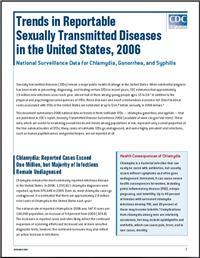Visit Website:
This report presents a summary of 2006 surveillance data on trends in STDs in the United States, including chlamydia, gonorrhea, and syphilis. The report examines overall trends, trends among at risk populations, including ethnic minorities and urban populations, gender differences, and the importance of screening. It is noted that chlamydia is the most commonly reported infectious disease in the US, that chlamydia diagnoses increased from 976,445 in 2005 to 1,030,911 in 2006, and the national rate of reported chlamydia in 2006 was 347.8 cases per 100,000 population, an increase of 5.6 percent from 2005. Gonorrhea cases reported were 358,366 in 2006, with a rate of 120.9 cases per 100,000 population, a slight increase from 115.6 in 2005. Primary and secondary syphilis cases increased from to 8,724 in 2005 to 9,756 in 2006, after decreasing in the 1990s and 2000. The national P and S syphilis rate increased from 2.9 cases per 100,000 in 2005 to 3.3 cases in 2006. Syphilis rates increased primarily in males, driven largely by cases among men who have sex with men. In 2006, the P&S syphilis rate among males is nearly six times the rate among females.
Format:
Report
Publication Date:
2007
ID:
35513
- STD/STI
- Chlamydia
- Gonorrhea
- Sexually Transmitted Diseases/Infections
- Syphilis


